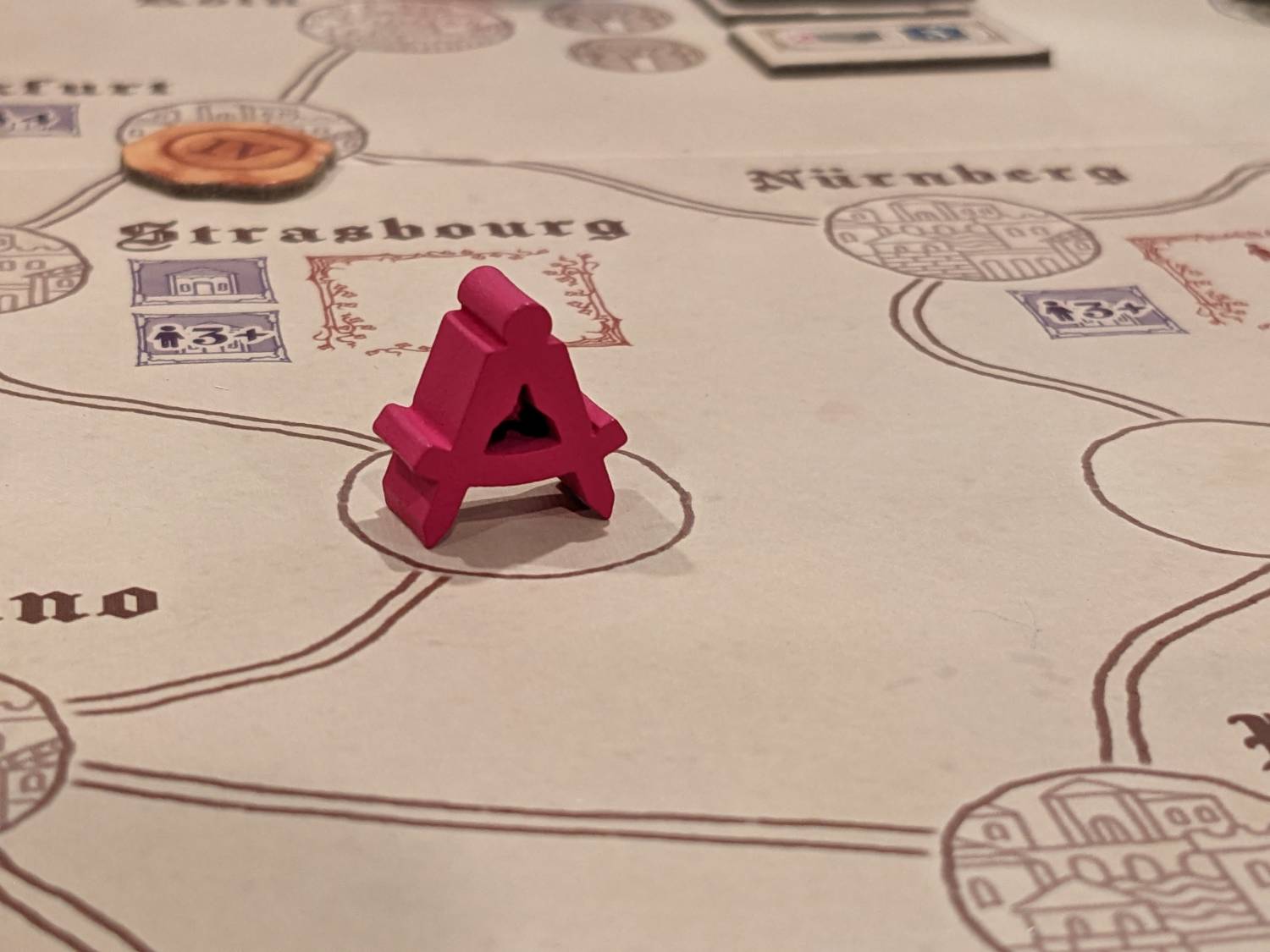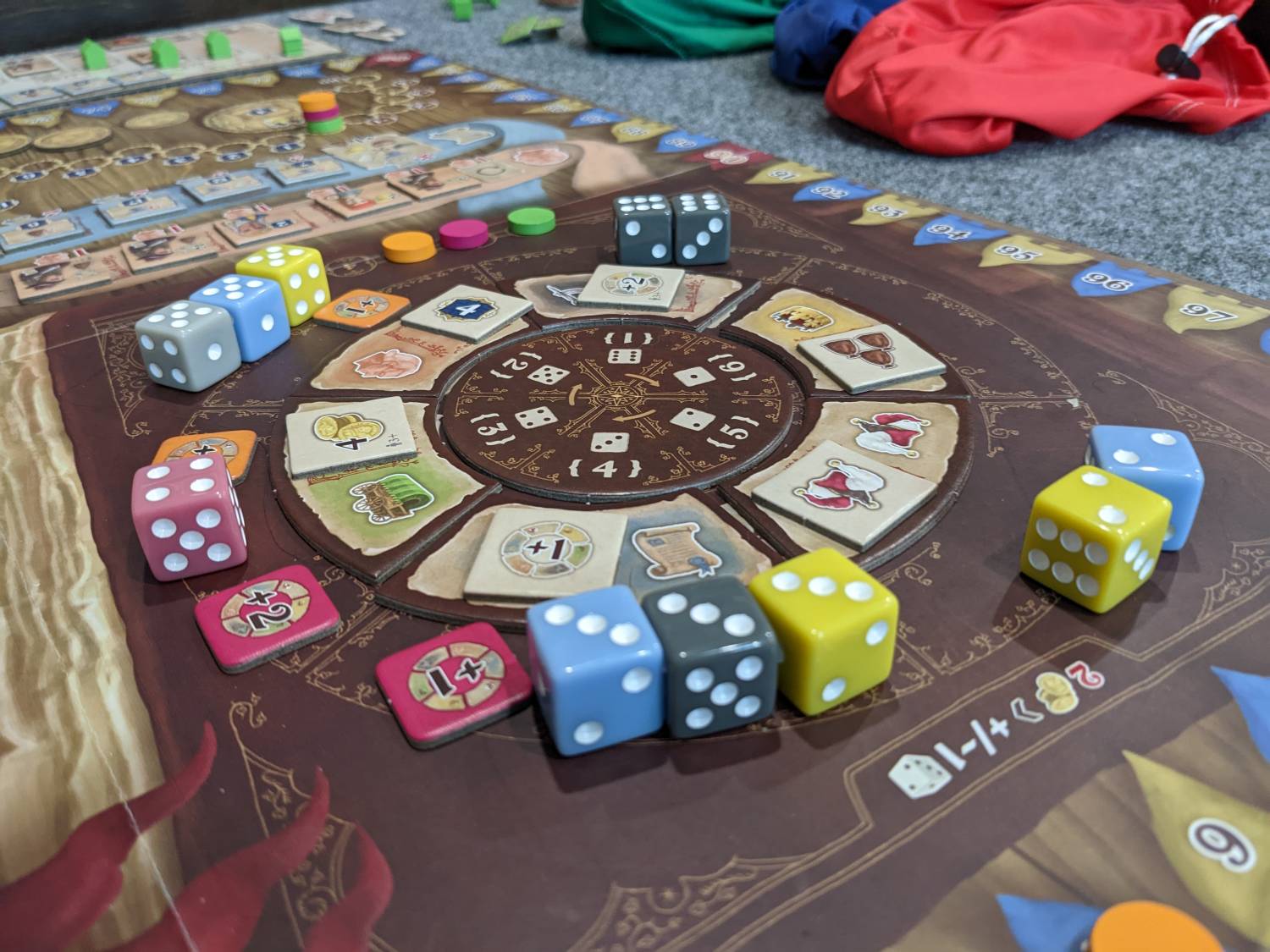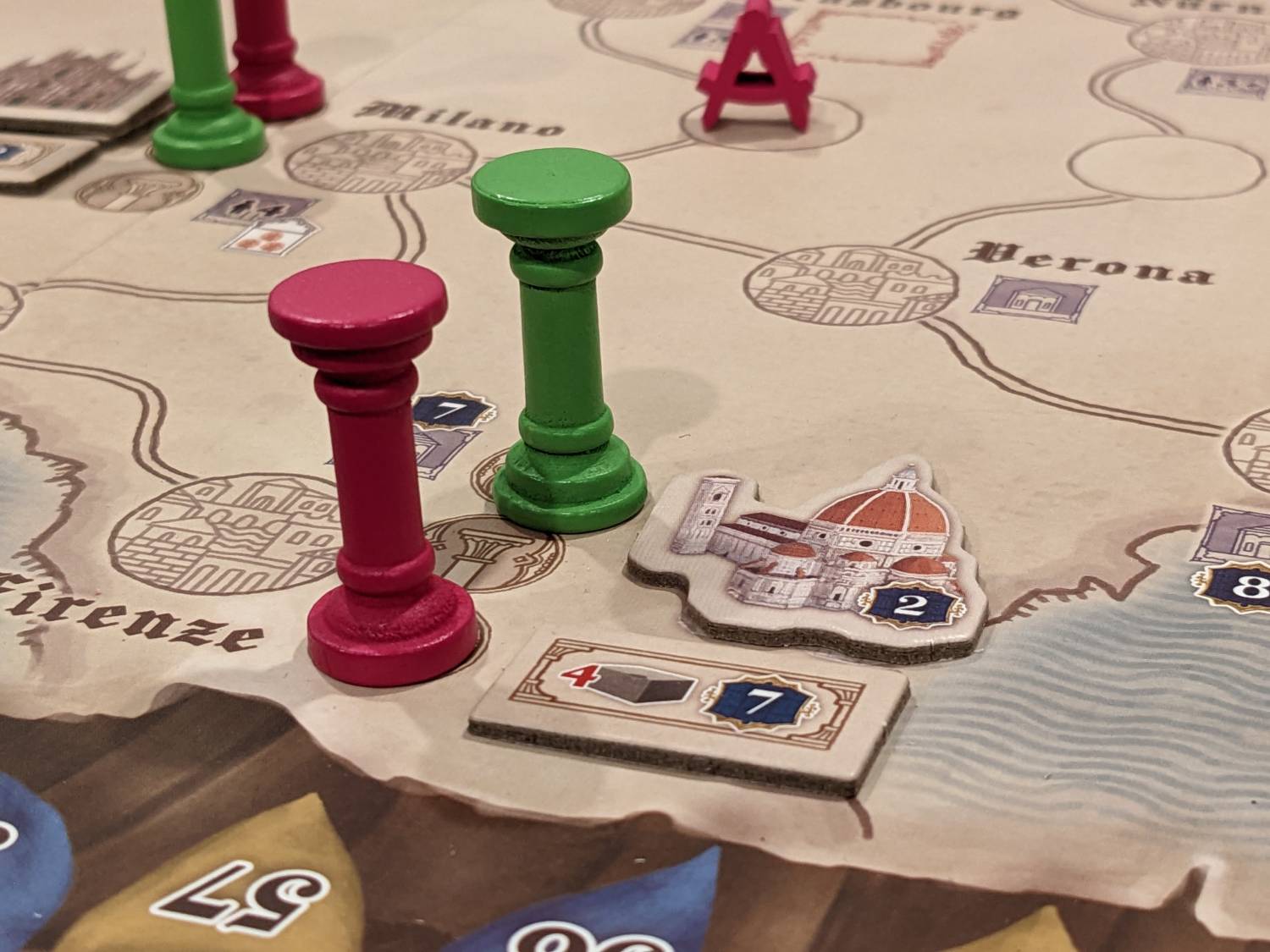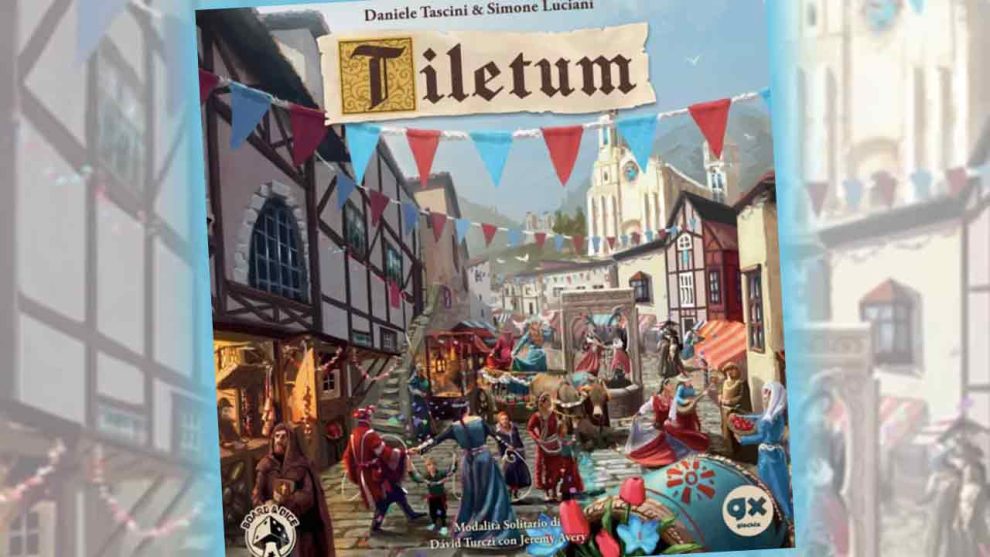Disclosure: Meeple Mountain received a free copy of this product in exchange for an honest, unbiased review. This review is not intended to be an endorsement.
“Did you like Tekhenu?”
I was sitting at Gen Con 2022 with Ola Sklodowska, Head of Marketing from Board&Dice. We were walking through the set up for their new game, Tiletum.
Even though we were wearing masks, I could tell my response surprised her:
“No,” I responded. “I didn’t like Tekhenu. But I’ve enjoyed most of the other games I’ve played from Board&Dice, and the designers on the cover of this one tell me I really want to know about Tiletum.”
The designers of Tiletum are Simone Luciani and Daniele Tascini. The latter is the co-designer of some of the most celebrated strategy games of the last 10 years, including the “T” games (heavy strategy endeavors, all of which start with the letter T): T’zolkin: The Mayan Calendar, Teotihuacan: City of Gods, The Voyages of Marco Polo, and Tekhenu.
But Luciani was the reason I was sitting at the demo table. Luciani has co-designed some of the best games I have ever played: Grand Austria Hotel (and the Let’s Waltz! expansion), Golem, and Lorenzo il Magnifico. In the case of two of these games—Grand Austria Hotel and Lorenzo il Magnifico—they hit the sweet spot for me: lots of interesting choices, medium weight games that I can play with casual or experienced gamers, efficiency puzzles that have dice, 90-minute playtimes, and combos.
Lots, and lots, of delicious combos.
So, as I was walking through the overview of Tiletum, I was holding my breath: would Tiletum lean into heavy territory, like Luciani’s Barrage or Tascini’s Tabannusi: Builders of Ur and Trismegistus: The Ultimate Formula, games so heavy I could feel my brain melting in my skull?
Tekhenu is in the same class of games as these other rules-heavy monsters, so when Ola set the stage by mentioning its name, I got a little nervous.
But with each passing minute, Ola’s words became more soothing; I also began to see why everyone at Board&Dice is so excited about Tiletum. The design is excellent and Tiletum will make gamers who love medium-weight efficiency puzzles very, very happy. Personally, I think Tiletum is more of a Luciani game than a Tascini game, in terms of feel and accessibility.

Make Them Count
Tiletum is set during “the Golden Age of the Renaissance”, so let’s call it the 15th century. As a wealthy merchant, you’ll spend your turns gathering resources to fulfill contracts, placing notable citizens in rooms on your player board, gaining favor with the King, and moving your two characters—a Merchant and an Architect—around the board to build Cathedrals and Houses in major cities of the era.
For those keeping count on their Eurogame score sheet, Tiletum lets players do all the following:
- Gather resources (surprise: wood is not one of them!!)
- Score end-of-round milestones
- Limit actions, but supply each player with bonus actions
- Roll dice, then manage said dice for deterministic, inverse functions
- Feature a scoring track that doubles as the first player selection feature
- Allow for scores that push well into the 200s
- Has no direct player interaction, but lots of indirect player interaction tied to racing other players to take limited building spaces on the board, snatching dice, and building more valuable Cathedrals before other players
- Bask in the glory of a dry theme in an actual European setting
And Tiletum does all of this as well as any mid-weight Euro I’ve played this year. In the category of easy to learn, difficult to master, Tiletum lays out each turn simply, then forces players to determine which way to most efficiently score a river of points.
That’s the thing: you’re going to score 125-150 points in Tiletum just by walking into the building. You are. The lowest score I have seen so far is 122 points, and my opponent had a couple of cocktails before playing. That will rightfully make some players call Tiletum a point salad, because almost everything in the game scores something.
While points come easily in Tiletum, maximizing turns is another story. What a player does with each action can really range based on the quality of the player.

The Actions, in Detail
When I was reading this section of the Tiletum rulebook, my eyes started to light up. Called “Actions in Detail”, I was struck by what I liked about some of the choices the game forces on a player, in part because everyone has not one, but two action pawns to worry about.
Every turn of Tiletum—12 of them across four rounds of play—requires the choice of a die from an Action Wheel. When each round of three turns begins, there are dice rolled and assigned around the Action Wheel.
The Action Wheel has six spaces for the five main actions—Merchant, Architect, Character, Contract, and King—plus the Joker action. An optional set of tiles can vary the order of where these spaces sit. The actions differ according to the aligned pips for each space.

Then, you have a choice. There are five colors of dice aligned with the five resources in the game: gold, iron, wool, stone, and food. The pips showing on the die are the number of resources you’ll get, i.e. pick a pink six-pip die, take six food. The pips that are on the opposing face of that standard D6 die are the number of Action Points you have for that action.
It was at this point during the teach when Ola’s eyes met mine. I could tell she knew she had me on the hook, since I’m guessing most gamers deciphered this moment and saw what I saw: limitless push-pull, min-max potential.
Every turn, you are making a tense choice that makes you sweat a little—my Euro brain says I want more stuff. My Euro brain also says I want more actions. But at what cost? Taking a one-pip yellow die means I get only one gold resource. But I get six Action Points for the chosen action.
Ooooooohhhhhh.
Another interesting element of the actions: there are five actions in Tiletum, with two of them driven by your player pieces.
The Architect and Merchant actions let you move those respective pieces around the map: when one arrives in a city with available spaces matching its action, you can use an action point to place either a Pillar (Architect) or a House (Merchant) to trigger additional abilities. Pillars are multiplied by Houses at game end to trigger your best chance at a large scoring bump, but each provide lots of in-game benefits too. In a city with a Pillar, players can use a bonus action to build a Cathedral.
To score during a Fair—the game’s term for end-of-round scoring milestones—players must have a House or their Merchant figure in the city listed at the top of the board’s scoring area to be eligible. These can trigger another massive river of points. In a recent game, I scored 40 points for one of these in a single round (in a game where I scored 243 points).
The Contract action is standard fare: choose tiles from a market which can be fulfilled at any time during your turn by spending the resources listed to score points. The Character action is more interesting: by using Action Points to take Character tiles from a constantly-replenished market (even replenished during an active player’s turn), you’ll find ways to draft tiles then place them on your player board, which immediately trigger minor bonuses. Place enough of these Characters and you’ll unlock more Houses to place during Merchant actions.
The King action is the one that I’m still working out, not because the action is difficult to explain, but because I’m not sure if you ever need to worry about it. This action pushes you up on a scoring track which could yield as many as 15 points at the end of each round, if you can keep your marker above water.
Above water? Well, at the start of each turn in a round (so, three times per round), a random token is revealed that names the number of spaces each player has to move down on the King track. This usually results in a number of negative points if not managed, but in a game where you might regularly score over 200 points, losing 3-5 points in a round four times isn’t that massive.
I still haven’t seen anyone try to manage the King track, but then again, I’ve not played any games yet where the majority of the dice are placed in the King action space for drafting.

Executive Actions, Indeed
“Justin, you promised me ‘delicious combos’, and I’m getting hungry.”
My apologies.
Here’s what I haven’t told you: before, between, and after your main dice-drafting action, you can do a whole bunch of things to extend the life of your turn.
You could start small, by trading two gold for any other single resource. Standard fare. You could also fulfill a contract by spending the resources from your supply to score points from the top of your player board, which unlocks additional Pillars for you to place later.
All good. But I promised “delicious”, so here’s an example.
In a recent three-player game, I took a one-pip iron die on the Architect action space. I collected my single iron resource, then fulfilled my second-to-last contract of the game for 13 points. Then, I used my six Action Points as follows:
- I moved three spaces, from Troyes to Milano (modern-day Milan)
- I spent a point to place a Pillar
- I paused to spend four stone to build a Cathedral in Milan, scoring 13 more points (seven points for the Cathedral and six points for spending four stone)
- I moved one space to Genova (Geneva)
- I used my final Action Point to collect a bonus tile on the Genova space: two Contract points
Then, I spent the two Contract points bonus tile right away. From the Contracts market, I used one Action Point to take a contract that I used on the final turn of the game, and the other point to trade resources. On the Contract action, you can trade resources, and the first time you do this each turn, you trade in one resource for any two resources.
I did that to turn a gold into two resources that I needed to fulfill another contract for nine more points, clearing more space in the Storehouse area of my player board where new tiles are added. And these moves set up my final action, so that I could score 20 points at the end-round Fair by getting five points for each of my four Cathedral tiles.
Every player seems to have 2-3 turns where they score 30-40 points on a single turn (or more!) and that feels good. Real good. Win or lose, that’s what I’m looking for in games: interesting choices, handsome rewards, and the chance to seem 25-30% smarter than I am in real life, if only for a single turn.
Tiletum has great moments like this every time.

The Highs and Lows of 15th-Century Europe
Some more things that Tiletum does well:
- There is a good chance I read more rulebooks than you do, so don’t take this lightly: the Tiletum rulebooks (for multiplayer and solo play) are the best rulebooks I have read this calendar year. They are shockingly easy to read. After my first readthrough, I did my first test play without needing to reference the book again. The books feature tons of examples of what each action does, everything is easy to find, every edge case is explained well, and the appendix at the end of the rules is fantastic. Kudos to Blazej Kubacki, Rainer Ahlfors, and Emanuela & Robert Pratt for solid rules.
- The game doesn’t get crafty with naming its actions. The Merchant action is the Merchant action. The Contract action is also easy to decipher. Action Points are used to take each part of an action. The iconography doesn’t lose its mind by trying to cram too many ideas onto a single space or card (I’m looking at you, Alma Mater!!!). Spaces on the board are very clear to see from all angles.
- The end-game scoring is clearly listed in the upper right-hand corner of the board.
- Here’s one that some games lately have blown: the Tiletum scoring track going around the board lists every single number from 1-100. Why don’t all high-scoring games do this?

Some misses:
- The board is comically bland. Sure, it’s easy to read, but not interesting in the slightest. Lots of space where someone’s great artwork could go, and no one bothered to consider that many games these days use a board as a work of art. Board&Dice doesn’t strike me as the kind of company that goes after this, focusing instead on tight mechanics, and that’s OK. Still, this board is sorta ugly.
- The only icon that I thought was a miss: the way Tiletum calls out that you can use an Action Point in the Contract action to trade one resource to get two the first time you do it during that action. Just…no.
- The dice bag isn’t big enough for a person with big hands (that person is me). When you are juggling in that bag to pull out the right number of dice, you will find that a die or two gets stuck in a corner, because the bag isn’t big enough. This doesn’t break the game, but for such an integral dice bag mechanic, you need to get this right.
- The resource tokens could have been better, but this is a Board&Dice thing, if Origins: First Builders is any indication. It won’t shock me if the BGG Store (or a gamer on Etsy) has upgrade bits available by next summer.
- Flipping Corruption tokens—and the King track in general—just doesn’t work well. In every game that I’ve played, someone has forgotten to flip those tokens. Worse, there’s not much drama here because all the tokens are negative. Are you going down zero, one or two spaces on the King track this turn? I essentially ignored the King track in my first solo play and I still beat the AI on Easy by over 100 points. The King track should matter, and the Corruption tokens don’t make it matter enough.
- There are not enough towns in the Fair selections for end-of-round scoring. Each game scores the first Fair based on having a House in Tiletum (modern day Tielt), which is easy, since all players place a House there during setup. There are 22 other Towns on the map, and only eight of them can be chosen for a Fair. The game’s variability will go way up with more Town tiles…which, of course, means expansion content is on the way.
- Tiletum absolutely needs player aids; every player who joined me for a game called this out, and I was surprised to not see one given the strength of the rulebook. A back cover cheat sheet would be a start, so I expect the game’s second print run to correct this. (All publishers: please refer to the back cover of Wild Space for the best example of a best-in-class, back-of-the-rulebook cheat sheet.)

The Solo
Tiletum has a solo mode designed by—wait for it!—David Turczi, and much like his other solo mode designs, the rules for solo are almost as long as the rules for the base game.
But that level of programming means that you have an AI that attacks the game logically, as opposed to many of the random solo decks out there that don’t align with the game’s milestones each round.
If you are using solo to justify buying Tiletum, I would skip it. That’s not because the game isn’t good solo—it is. Rather, it’s because Tiletum plays best as a game that is constantly adapting based on that round’s dice. The automa is driving too hard towards its mission, so it doesn’t pivot well at lower difficulties.

Buy This Game As Soon As You Can
Tiletum is excellent and is solid mid-weight fare for those who love Eurogaming experiences. It’s easy to teach, features lots of delightful, easy-ish on the brain crunch, and can be won in many different ways. Expansion content will likely address any of the bumps players encounter over the next few months; I can already see room here for expanded options for Fairs and Towns, different contracts, more Helper tiles used for bonus actions, and a fix to the game’s King track.
I love Tiletum, and I’m definitely keeping this one in my collection. It’s not going to provide the long-term depth of Grand Austria Hotel, but for now, I expect to enjoy Tiletum’s style of crunch.
There is one significant negative about Tiletum that I need to call out here, though: downtime.
Do not play Tiletum at four players; the analysis paralysis here is real, especially when staring at a full plate of dice to start a round. (Late in a round, it’s pretty simple to figure out which of the 3-4 remaining dice are best.)
In a four-player game, the first player will have to choose from 14 dice at the start of a round, knowing that there’s a good chance that another player will snipe a good die for your strategy before your turn comes back around.
Tiletum at three players was consistently between 2-2.5 hours, on the longer end when everyone was new to the game. The box says Tiletum is a 60-100 minute game—uh, no. There is no way I can imagine four players getting this done in under two hours, let alone 100 minutes.
Stick to playing Tiletum with two or three players and I think you’ll be fine. I’m hoping to get a regular group of players who know the game, so that a three-player game can be finished in under 90 minutes. That way, Tiletum will hit the table regularly. Across my five plays to prepare for this review (one solo, one two-player game, two three-player games and one four-player game), I am finding that two players is my preferred player count. When it’s not your turn, you can begin analyzing which dice your opponent will not draft to further your strategy.
This has been an incredible year for great Euro-style gaming experiences; between Tiletum, Carnegie, Witchstone, Space Station Phoenix, Grand Austria Hotel: Let’s Waltz!, Origins: First Builders, Circadians: First Light and Khôra: Rise of an Empire, choices for our Euro game of the year are going to be tough!!












Enjoyed your article, stay warm and be safe up there. We are experiencing some nice weather here in Oklahoma!